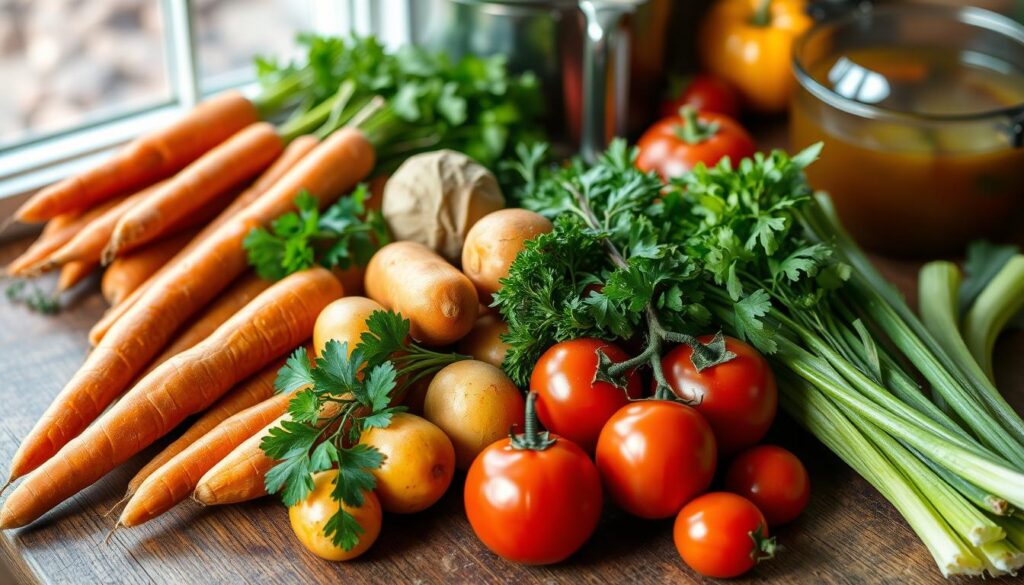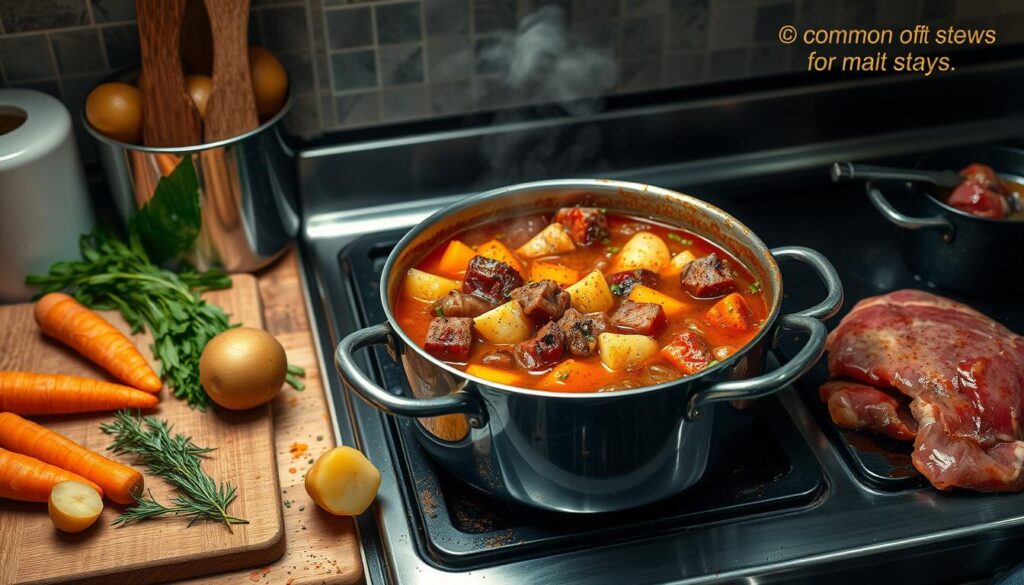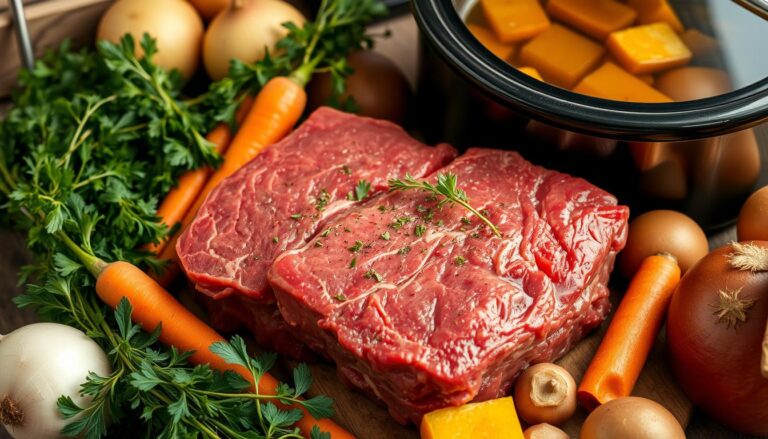How to Make Beef Stew: Simply Recipes for Beginners
Growing up in a busy Midwestern kitchen, I learned that beef stew recipes are more than food. They’re memories waiting to be made. The smell of cooking meat and veggies always brought us together. It turned simple ingredients into something truly special.
Making an easy beef stew is more than following a recipe. It’s about creating a meal that feeds both your body and soul. This guide will show you how to make a delicious, hearty dish that feels like home.
Beef stew is not just tasty. It’s also packed with nutrients like protein, iron, and zinc. These help your muscles and boost your immune system. Whether you’re new to cooking or experienced, this guide will help you make a perfect beef stew every time.
Table of Contents
Understanding the Basics of Traditional Beef Stew
Making a hearty beef stew is more than just throwing ingredients together. It’s an art that blends classic methods with simple ingredients. This creates a comfort food stew that warms your heart. Knowing the basics can turn your beef stew recipes from good to great.
Before we start cooking, let’s look at the key ingredients for a memorable beef stew.
Essential Ingredients for Classic Beef Stew
A traditional beef stew needs the right ingredients. Here’s what you’ll need:
- 2 lbs beef chuck, cut into 1-inch cubes
- 4 large carrots, chunked
- 1 large onion, chopped
- Baby potatoes (1 lb)
- 4 cups beef broth
- Seasonings: salt, black pepper, bay leaves
Equipment You’ll Need
The right tools can make your stew better. Here are the essentials:
| Equipment | Purpose |
|---|---|
| Dutch Oven | Even heat distribution, perfect for slow cooking |
| Sharp Knife | Precise meat and vegetable cutting |
| Cutting Board | Safe surface for ingredient preparation |
| Large Wooden Spoon | Stirring and mixing ingredients |
Time and Temperature Considerations
Mastering beef stew recipes means understanding cooking basics. Patience is key. Cooking low and slow makes tough meat tender. Aim for a gentle simmer at 325°F for 1.5 to 2 hours.
“The secret to a perfect stew is allowing flavors to develop slowly and naturally.” – Professional Chef
By following these tips, you’ll make a hearty beef stew that your family will love.
Choosing the Right Cut of Beef for Your Stew
Choosing the right meat for stew is key for home cooks. Not all beef cuts are good for a tasty, tender stew.
Experts say boneless chuck roast is the best for stew. It’s great because of its:
- Rich marbling that melts in slow cooking
- High fat for more flavor
- Affordable price
- Becomes tender with long cooking
J. Kenji López-Alt has a smart tip for stew meat. Don’t cut meat into small cubes first. Instead, sear larger steaks. This cuts down prep time and boosts flavor.
“Pre-packaged stewing beef is a risk,” warns López-Alt. He stresses the need for quality meat.
For those who like to try new things, consider these cuts:
- Boneless short ribs (more luxurious but pricier)
- Brisket (gives deep, rich flavors)
- Bottom round (a leaner choice)
The secret to great stew meat is knowing how cuts cook. Chuck roast is still the top pick for easy, tasty stews.
Beef Stew Simply Recipes: A Step-by-Step Guide
Making a tasty one-pot beef stew is easy. With the right steps, simple ingredients turn into a warm, hearty meal. Here’s how to make a classic beef stew that’s both simple and full of flavor.
Meat Preparation Techniques
Begin with 2.5 pounds of boneless beef chuck roast. Cut it into 1-1/2 inch cubes for even cooking and tenderness. Coat the beef cubes with 1/4 cup of all-purpose flour. This step seals in moisture and adds richness to your stew.
- Cut beef into uniform 1-1/2 inch cubes
- Season with salt and pepper
- Coat with flour for enhanced texture
- Brown in 1 tablespoon of vegetable oil
Vegetable Preparation Methods
Choose fresh veggies that match the meat’s flavor. Dice 2 medium onions, 2 large Russet potatoes, 3 medium carrots, and 2 celery stalks. Add 8 ounces of whole mushrooms for extra flavor.
Creating the Perfect Broth Base
The key to a great stew is a rich broth. Use 2 large beef bouillon cubes, 10.75 ounces of condensed tomato soup, and 3 teaspoons of Italian seasoning. Add 2 bay leaves and 1/2 teaspoon of black pepper for more flavor.
“A great stew is about layering flavors and allowing ingredients to meld together slowly and deliciously.”
Your classic beef stew will be ready in about 30 minutes. It makes 6 servings, each with 556 calories and a good mix of nutrients.
No-Brown Method for Easy Beef Stew
Want a simple beef stew without extra work? The no-brown method is here to save you time and clean up. It skips the meat browning step, yet still gives you a tasty, filling meal.
Why pick the no-brown method for your stew? It’s great for busy cooks who want flavor without fuss. It cuts down cooking time and makes prep easier.
“Simplicity is the ultimate sophistication in cooking” – Kitchen Wisdom
Here are the no-brown method’s main benefits:
-
- Faster meal prep
-
- Less mess in the kitchen
-
- Shorter cooking time
-
- Just as tasty results
For the best results, follow these tips:
-
- Choose top-notch beef cuts
-
- Season the meat well before cooking
-
- Pick a rich beef stock
-
- Let the stew simmer slowly
Pro tip: To boost flavor without browning, marinate your beef in a strong seasoning mix for 30 minutes before cooking.
Your no-brown stew can still be full of flavor. Focus on quality ingredients and seasoning. The secret is patience, letting the flavors blend slowly.
Secret Tips for Tender, Flavorful Meat
To make a family-friendly beef stew special, you need to know a few tricks. The secret to tender meat is in how you season and cook it.
Mastering Meat Preparation
When making beef stew, temperature and seasoning are key. Start by letting your beef sit at room temperature for about 30 minutes before cooking. This helps it cook evenly and stay tender.
-
- Use chuck, brisket, or bottom roast for best results
-
- Season generously with kosher salt and black pepper
-
- Allow 2 pounds of meat for a hearty serving
Seasoning Secrets
Seasoning is what makes your stew go from good to great. Add 2 teaspoons of herbes de Provence or Italian seasoning for extra flavor. The right mix of spices can make your stew taste like it’s from a restaurant.
| Seasoning | Quantity | Purpose |
|---|---|---|
| Kosher Salt | 3/4 teaspoon | Base flavor |
| Black Pepper | 1/2 teaspoon | Spice enhancement |
| Garlic Powder | 1/2 teaspoon | Aromatic depth |
Cooking Time Management
The “low and slow” method is essential for tender meat. Cook at a temperature between 284°F and 320°F. Aim for 4-6 hours of cooking to make the meat fall-apart tender.
“Patience is the secret ingredient in creating the most tender beef stew.”
The goal is to make a beef stew that’s more than just a meal. It should be a special experience for your family.
Essential Vegetables and Their Preparation

Vegetables are key to making delicious meat stew recipes. Choosing the right ones can make your beef stew stand out. Classic stew recipes use a mix of vegetables that add flavor and nutrition.
Classic Vegetable Selection
Here are the must-have vegetables for your stew:
-
- Carrots: Sweet and hearty
-
- Potatoes: Creamy and filling
-
- Onions: Provide rich flavor base
-
- Celery: Adds subtle aromatics
How you cut your vegetables is important. Uniform sizes ensure even cooking and texture. Cut them into 1-inch chunks for best results.
“The secret to a perfect stew is in the vegetable preparation” – Professional Chef
Vegetable Preparation Techniques
Here are some tips for preparing your vegetables:
-
- Wash vegetables thoroughly
-
- Cut into consistent sizes
-
- Add robust vegetables first
-
- Layer delicate vegetables later
| Vegetable | Cooking Time | Nutritional Benefit |
|---|---|---|
| Carrots | 30-45 minutes | High in Vitamin A |
| Potatoes | 15-20 minutes | Complex carbohydrates |
| Onions | 7-10 minutes | Antioxidant properties |
Proper vegetable preparation can take your stew to the next level. Try different combinations to find your favorite.
Creating Rich and Hearty Gravy
Making the perfect gravy is key to turning a simple beef stew into a memorable dish. A hearty beef stew needs a rich, velvety sauce to tie all flavors together.
Thickening Techniques for Perfect Consistency
When you’re making beef stew, getting the gravy right is essential. You can use a few methods to get that perfect texture:
-
- Flour and butter method: Mix 2 tablespoons of flour with softened butter to make a roux.
-
- Direct flour coating: Dust the meat with 3 tablespoons of all-purpose flour before browning.
-
- Tomato paste technique: Add 1/4 cup of tomato paste to deepen the flavor and thicken slightly.
Balancing Seasonings for Maximum Flavor
For a top-notch gravy, balance your seasonings carefully. Here are some expert tips:
-
- Use 2 teaspoons of dried thyme.
-
- Add 1 teaspoon of salt.
-
- Incorporate 1/2 teaspoon of black pepper.
-
- Try 1 teaspoon of dried basil.
“A great gravy transforms a good stew into an unforgettable meal.” – Culinary Wisdom
Your aim is to make a gravy that enhances the beef’s flavor and has a smooth texture. Try these methods to make your beef stew as good as a restaurant’s.
Slow Cooker Adaptation Methods
Turning your traditional beef stew into a slow cooker beef stew makes cooking easier. This method lets you cook a tasty meal without much effort. It’s perfect for busy people or anyone who wants to make cooking simpler.
To make an easy beef stew in a slow cooker, just follow these steps:
-
- Choose a beef cut like chuck roast that’s well-marbled
-
- Cut the meat into 1-1/2 inch cubes
-
- Brown the meat briefly before adding it to the slow cooker (optional but recommended)
-
- Layer the ingredients carefully
Cooking times depend on the heat setting you choose:
| Heat Setting | Cooking Duration |
|---|---|
| Low Heat | 7-8 hours |
| High Heat | 4-6 hours |
“The magic of slow cooking is patience and allowing flavors to develop gradually.” – Professional Chef
Tip: To avoid a watery stew, don’t add too much liquid. The meat and veggies will release their own moisture. If it’s too thin, thicken it in the last 30 minutes by mixing cornstarch with cold water and stirring it in.
Common Mistakes to Avoid

Making the perfect beef stew is more than just following a recipe. Even skilled cooks can make mistakes that ruin their dish.
Temperature Control Challenges
Beef stew needs careful temperature control. Wrong heat can turn tender meat into tough pieces. The goal is to cook at a low simmer, so the meat breaks down slowly.
-
- Avoid high heat during cooking
-
- Maintain a consistent low temperature
-
- Use a Dutch oven for even heat distribution
Seasoning Mistakes to Sidestep
Seasoning is crucial for a great beef stew. Too little seasoning makes it taste bland, while too much overpowers the flavors.
| Seasoning Mistake | Impact | Solution |
|---|---|---|
| Adding salt late | Uneven flavor distribution | Season early in cooking process |
| Using only water | Weak flavor profile | Use beef stock instead |
| Over-thickening | Gravy-like consistency | Use minimal thickening agents |
“Cooking is about precision, passion, and understanding your ingredients.” – Professional Chef
Remember, beef stew recipe ideas are just suggestions. Trust your taste and adjust seasonings as you go. Making the perfect beef stew takes time and patience.
Storage and Reheating Guidelines
Keeping your comfort food beef stew fresh is key. After a big meal, you’ll want to keep those tasty flavors for later.
Refrigeration Guidelines
Storing your beef stew in the fridge is easy. Use an airtight container to keep it fresh. Here are some tips:
-
- Store in sealed containers immediately after cooling
-
- Refrigerate within 2 hours of cooking
-
- Keep for up to 5 days maximum
Freezing Methods
Freezing is great for keeping your stew longer. Just follow these steps:
-
- Cool the stew completely before freezing
-
- Use freezer-safe containers or heavy-duty freezer bags
-
- Remove excess air to prevent freezer burn
-
- Freeze for up to 3 months
Reheating Techniques
Reheating your stew right is important. It keeps the taste and texture great:
-
- Thaw frozen stew in the refrigerator overnight
-
- Reheat on the stovetop over medium-low heat
-
- Stir occasionally to prevent scorching
-
- Add a splash of broth if the stew seems too thick
-
- Heat until the internal temperature reaches 165°F
“A well-stored stew is like a culinary time capsule, preserving the warmth and comfort of a home-cooked meal.” – Culinary Wisdom
Nutritional Preservation
| Storage Method | Duration | Best Practices |
|---|---|---|
| Refrigerator | 3-5 days | Airtight container, below 40°F |
| Freezer | Up to 3 months | Freezer-safe container, remove air |
By following these tips, your beef stew stays delicious all week.
Serving Suggestions and Accompaniments
Your beef stew simply recipes deserve the perfect sides to make your meal special. A great side can turn your hearty beef stew into a memorable feast.
“The right side dish can make your beef stew shine brighter than the main course!” – Home Cooking Expert
Here are some tasty pairings for your beef stew:
-
- Crusty Artisan Bread for Dipping
-
- Creamy Mashed Potatoes
-
- Cornbread Muffins
-
- Light Crunchy Side Salad
Wine lovers can choose wines that complement their meal. Beef stew simply recipes go well with full-bodied wines like Cabernet Sauvignon or Syrah.
| Wine Pairing | Flavor Profile |
|---|---|
| Cabernet Sauvignon | Bold tannins, dark fruit notes |
| Syrah/Shiraz | Peppery, dark berries, smoky undertones |
Pro tip: Make your sides ahead of time. This way, you can enjoy your hearty beef stew without stress.
Conclusion
Learning to make beef stew is more than just following a recipe. It’s about creating a meal that comforts you and shows off your cooking skills. This guide has given you the tools to turn 2 pounds of beef into a rich, flavorful dish. Each serving has 30 grams of protein.
The secret to a great stew is knowing how to mix ingredients, cooking time, and technique. Now, you can make a stew that cooks for 2 hours. This makes the flavors deep and the meat tender. Remember, the more you practice, the better you’ll get.
Keep trying new things with beef stew recipes. You can use a slow cooker for 8 hours or add different veggies like beans or mushrooms. Your stew can become a special dish that warms people’s hearts and fills their bellies.
The most important thing is to enjoy the cooking process. Trust your instincts and make a meal that feeds both your body and soul. Your beef stew journey is just starting, and the possibilities are endless.







